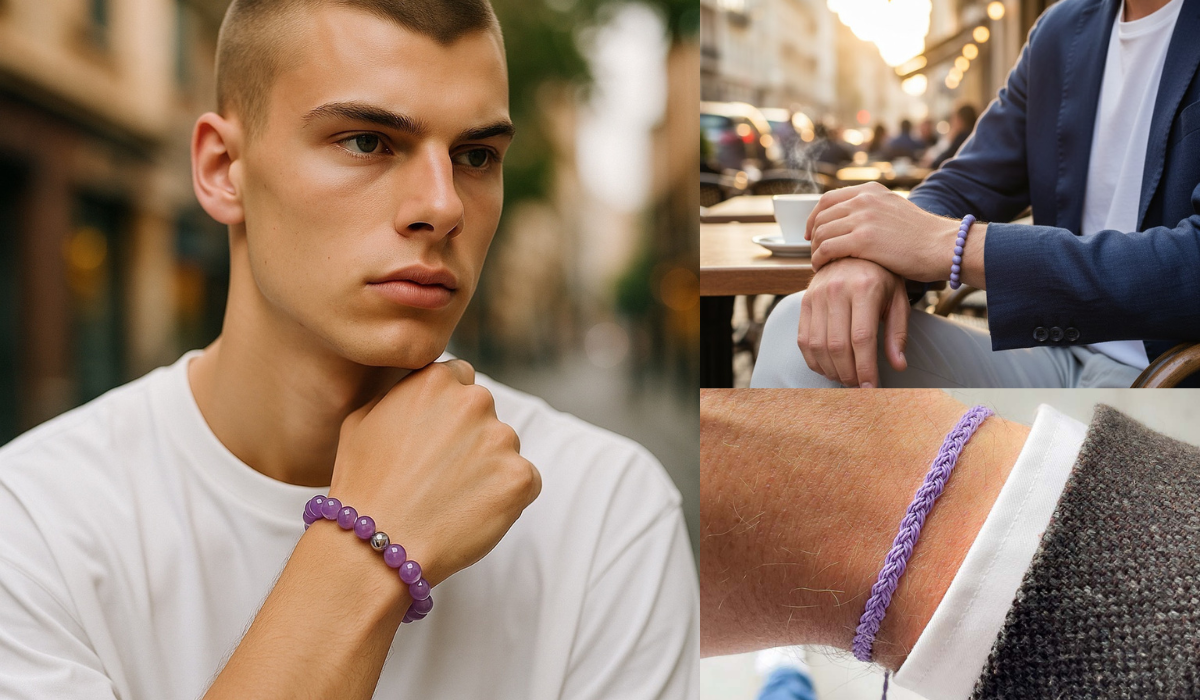In the ever-evolving world of accessories, one piece is quietly making its mark: the Naiam Cosmetic Man Lilac Bracelet. At first glance, it might just look like another trendy wrist-adornment. But dig a little deeper and you’ll discover a design that balances subtle flair with masculinity, a color tone that communicates confidence and softness at the same time, and a wearable that reflects more than just fashion—it reflects identity.
What sets the bracelet apart?
1. Color symbolism and fashion context
The choice of lilac isn’t arbitrary. Lilac sits at the intersection of pastel softness and confident hue—it carries with it a sense of calm, creativity, and introspection. In men’s accessories, purple tones (including lilac) have been steadily moving out of niche into mainstream, offering an alternative to more traditional silver, black, or gold bracelets. Wearing a lilac bracelet can say many things: “I’m aware of style but not overly flashy”, “I embrace nuance and subtle contrasts”, or “I bring thoughtful choices to my wardrobe”.
2. Design ethos and materials
While specific details about the Naiam Cosmetic Man Lilac Bracelet’s materials may vary, the typical premium bracelet of this sort will combine quality elements like stainless steel clasps, bead or cord structure, and sometimes semi-precious accents. What makes this one interesting is the union of masculine structure (chunky yet refined beads, secure fastening) with the softness of hue and minimalist styling. The result: you don’t feel that your wrist piece is “feminine”; instead, it feels contemporary and intentional.
3. Versatility
One of the strongest selling points is that it bridges different style moods. Dressed up with a blazer or sport coat, the lilac tone introduces a muted pop of color that doesn’t clash with standard office or evening wear palettes. On the other hand, with casual wear (jeans and tee, or layered with other bracelets) it works as a style anchor—something that elevates the outfit without screaming “look at me”.
How to style it
- With neutral tones: Pairing the bracelet with whites, greys, blacks, or navy keeps the accessory in focus without overwhelming the look. The lilac hue becomes a subtle accent.
- Layering: For more relaxed outfits, layering the bracelet with a leather strap or a slim metallic band can build texture without confusion. Keep one or two pieces only to avoid looking overcrowded.
- Fabric contrast: The interplay between a soft pastel hue and more rugged fabrics (denim, canvas, mission-style jackets) plays out well. It softens the tougher elements without compromising masculine feel.
- Watch vs. bracelet balance: If wearing a wristwatch on one side, keep the opposite wrist (or the same wrist but further up) for the bracelet so the two pieces don’t fight for attention.
Why it matters beyond style
Expression of identity
Accessories serve as tiny signals about who we are and what we value. Choosing a lilac bracelet for men says: “I care about style nuance,” and perhaps “I’m open to exploring beyond classic masculine tropes.” In a world where men’s fashion is becoming more expressive, this kind of piece offers a meaningful way in.
Psychological impact
Wearing a subtly distinctive piece can instill a kind of confidence—neither loud nor invisible. It’s a personal note, often only picked up subconsciously by others, but that matters. The color lilac is linked with calmness and creativity, so it might also have a positive effect on how you feel and how you present yourself.
The story-element
Every accessory carries a story, whether the wearer knows it or not. A bracelet like this invites questions, compliments, conversation: “Nice bracelet, where did you get it?” That moment of interaction helps build personal narrative around what you wear.
Considerations before purchasing
- Fit and sizing: Make sure the bracelet fits your wrist properly—not too tight (which can hinder movement) or too loose (which can spin and feel distracting). Check if sizing is adjustable or if different sizes are offered.
- Material durability: Ensure the beads/cord/metal are of decent quality. Cheap materials can fade, tarnish, or break, which diminishes both style and value.
- Color tone: “Lilac” can vary widely—some are pale, some richer. Try to see real life photos (wrist shots) to confirm the tone suits your skin and wardrobe.
- Care and maintainance: Some bracelet materials (like thread or delicate beads) require more care (avoiding water, sweat, rough handling). Keep this in mind if you’ll wear it daily.
- Brand authenticity and value: As with any accessory, check brand reputation, craftsmanship, return policy, and packaging. Even if you’re not buying luxury, you want good value.
Situations where it shines
- Casual Social Outings: Lunch with friends, gallery visits, coffee meets—here the bracelet acts as a relaxed style signature.
- Smart-Casual Work Environment: If your office allows subtle accessories, the lilac bracelet is a clever way to differentiate your wrist style.
- Evening Events: With darker suits or monochrome outfits, this pop of color can subtly elevate your ensemble without flashy jewellery.
- Travel and Leisure: When you’re mixing comfort and style (vacation, city exploring), this accessory works brilliantly to keep you looking curated yet relaxed.
Possible drawbacks
- Perception Risk: If you’re in a very conservative fashion environment that expects strictly traditional masculine jewelry (plain metal cuff, no color), you might get raised eyebrows. It’s not guaranteed—many workplaces are opening up—but be aware of context.
- Maintenance: If the bead or cord is prone to wear, you may need to replace or repair more frequently than a classic metal bracelet.
- Trend-cyclic: Color accessories can be trend-sensitive. While lilac may have good staying power, the specific style might feel less “fresh” in some years.
Final thoughts
The Naiam Cosmetic Man Lilac Bracelet presents a thoughtful alternative to the usual male wrist accessories. It’s not about flashy bling or bold statement pieces—it’s about subtlety, personality, and intention. If you’re a man who cares about how you present yourself, wants a functional and stylish accessory, and isn’t afraid to embrace color’s quiet power, this bracelet could be a meaningful addition to your wardrobe.
FAQs
Q: Who is this bracelet suitable for?
A: It’s suitable for men who appreciate accessories that are stylish but not showy, who want a subtle accent in their look. It works across casual and smart-casual contexts.
Q: What color combinations work best with a lilac bracelet?
A: Neutral tones like white, grey, navy, black. Also soft pastel shirts, light denim, or even darker earth tones for contrast. Avoid too many competing bright colors that might overwhelm the lilac hue.
Q: How do I choose the right size?
A: Measure your wrist circumference and check the sizing offered. A snug fit is better than a loose one. If adjustable, pick one that allows a little movement but doesn’t slide around all day.
Q: How can I maintain and care for it?
A: Keep it away from excessive moisture and chemicals (e.g., chlorinated pool, salt water). If beads are used, avoid sharp impacts. If cord or thread is part of the design, it might require more gentle treatment than full-metal bracelets.
Q: Can it be layered with other bracelets or a watch?
A: Yes — just keep balance in mind. If you wear it with a watch, ensure the other wrist is free or add only one matching piece to avoid visual clutter. If you layer it, pick one complementary bracelet (e.g., leather strip, slim chain) so the lilac one remains distinct.
Q: Is lilac a color only for certain age groups?
A: Not at all. Lilac can work across age groups. The key is styling it appropriately — how you pair it with the rest of your outfit will determine whether it reads youthful or mature.
Q: Does choosing a colored bracelet mean I’m making a fashion statement?
A: In a sense yes — color in men’s jewellery is less common than neutral metal, so choosing a lilac bracelet does express some intentional style. But it doesn’t have to be bold: when styled right, it is elegant and low-key rather than loud.

